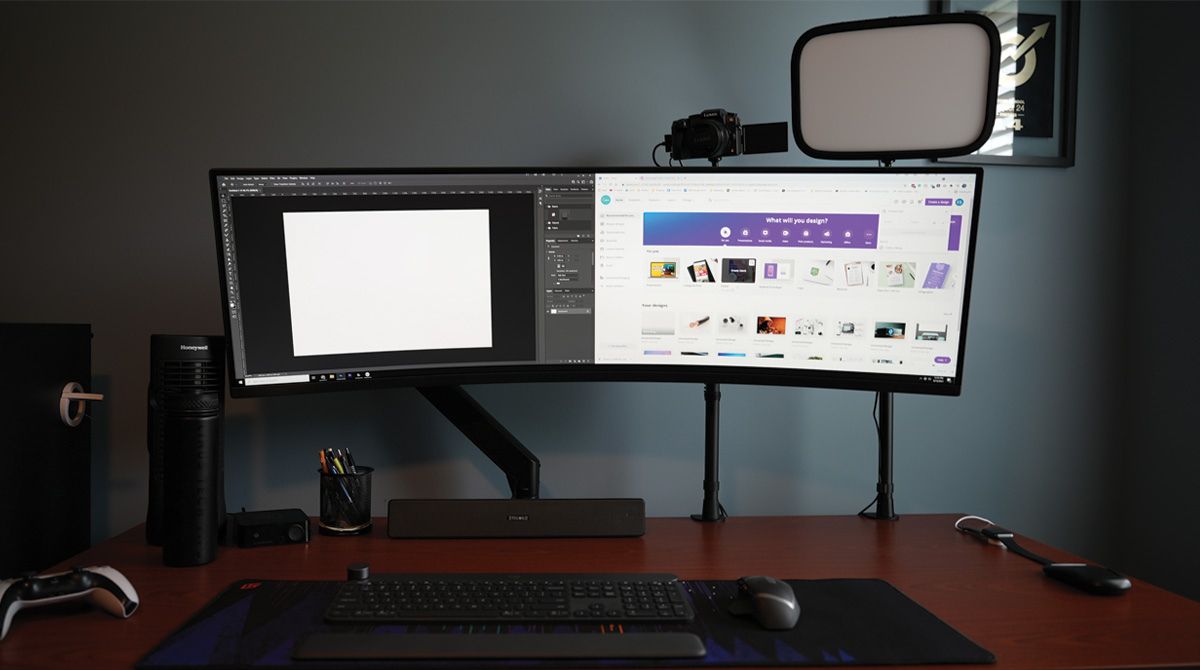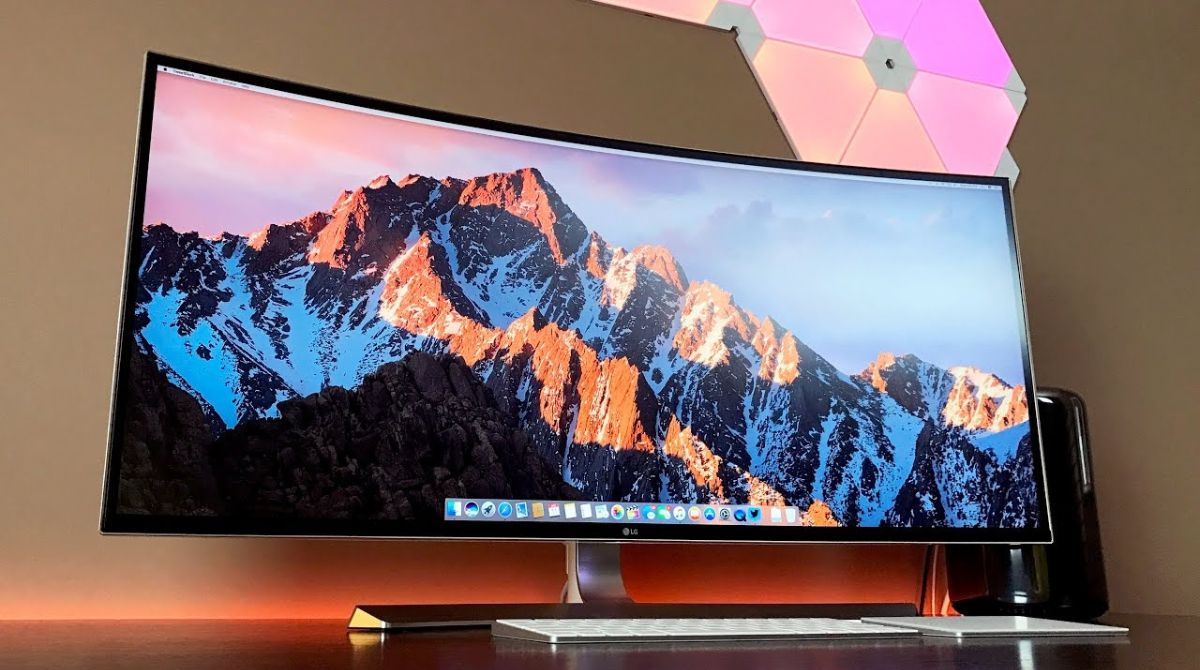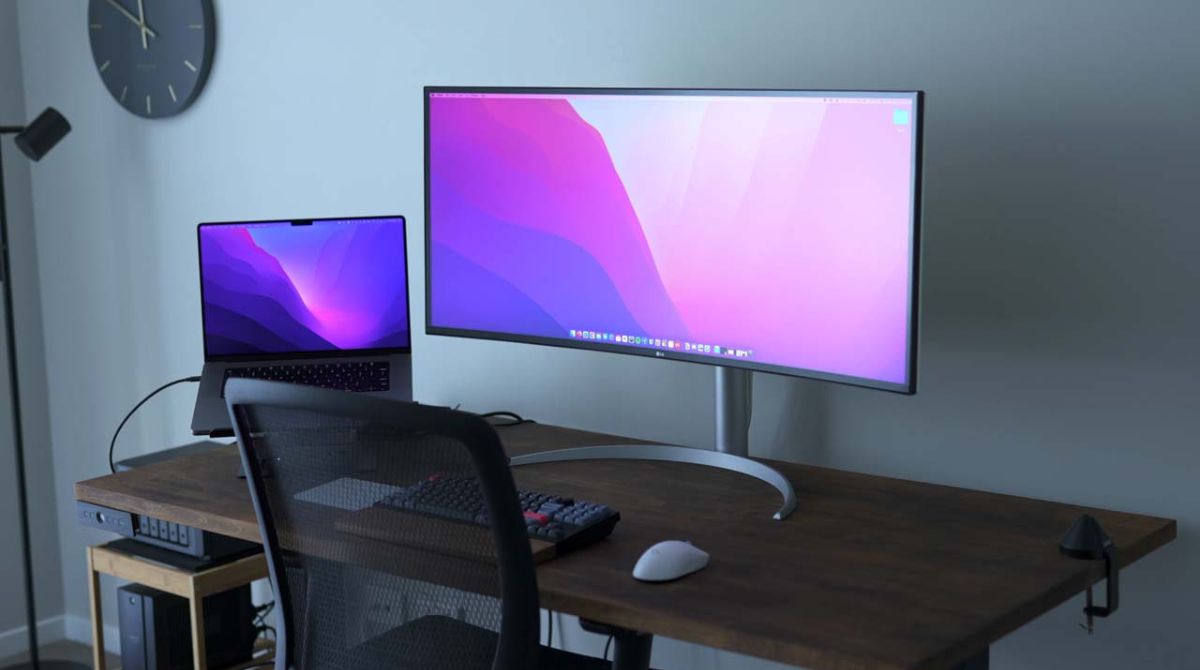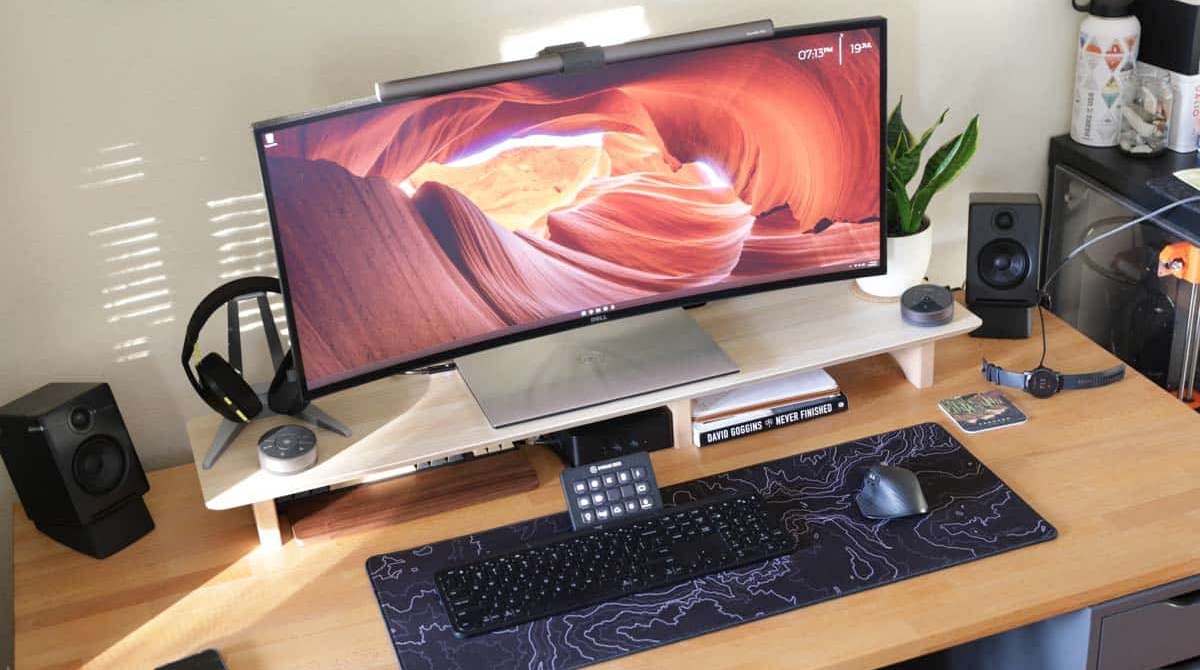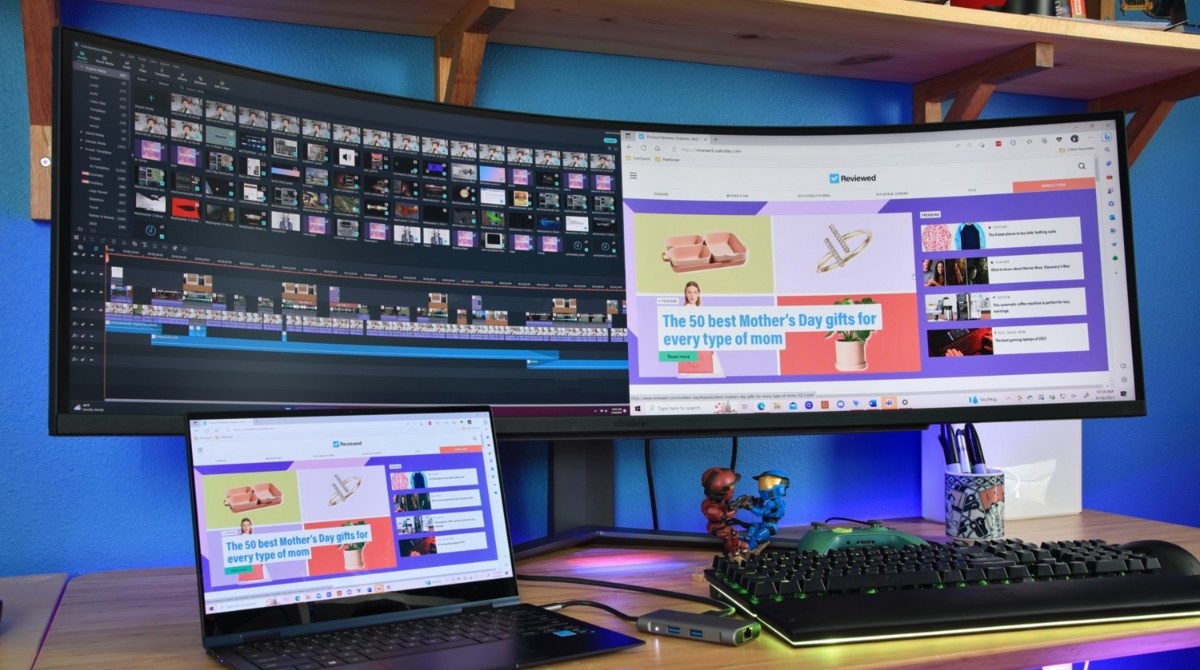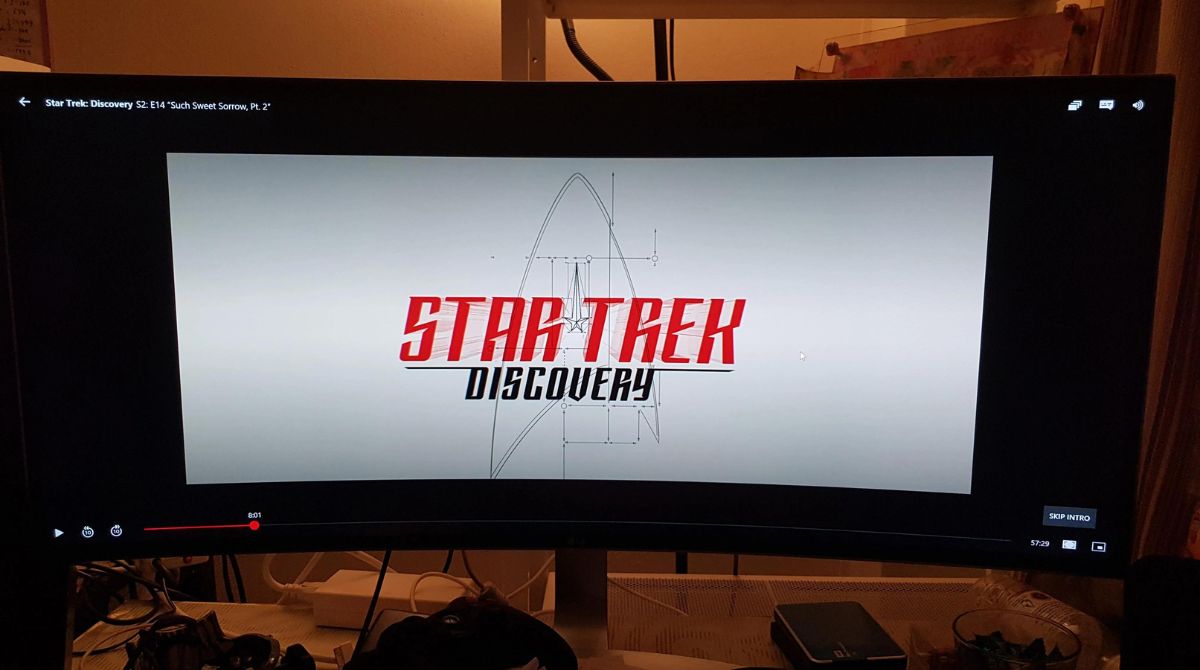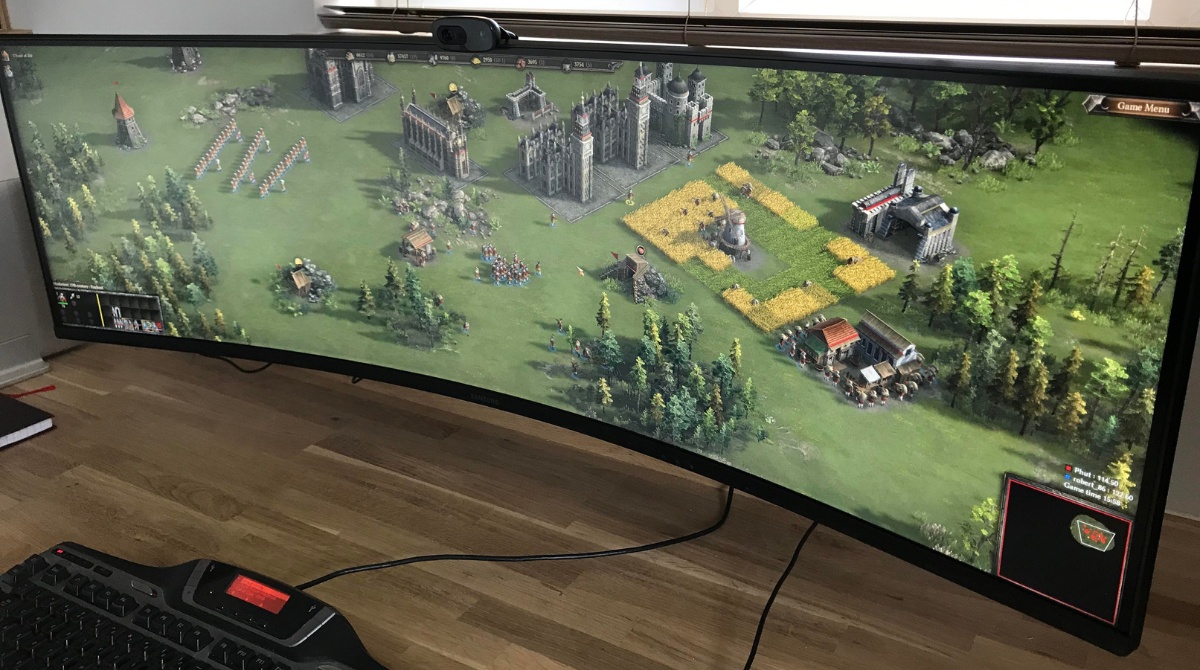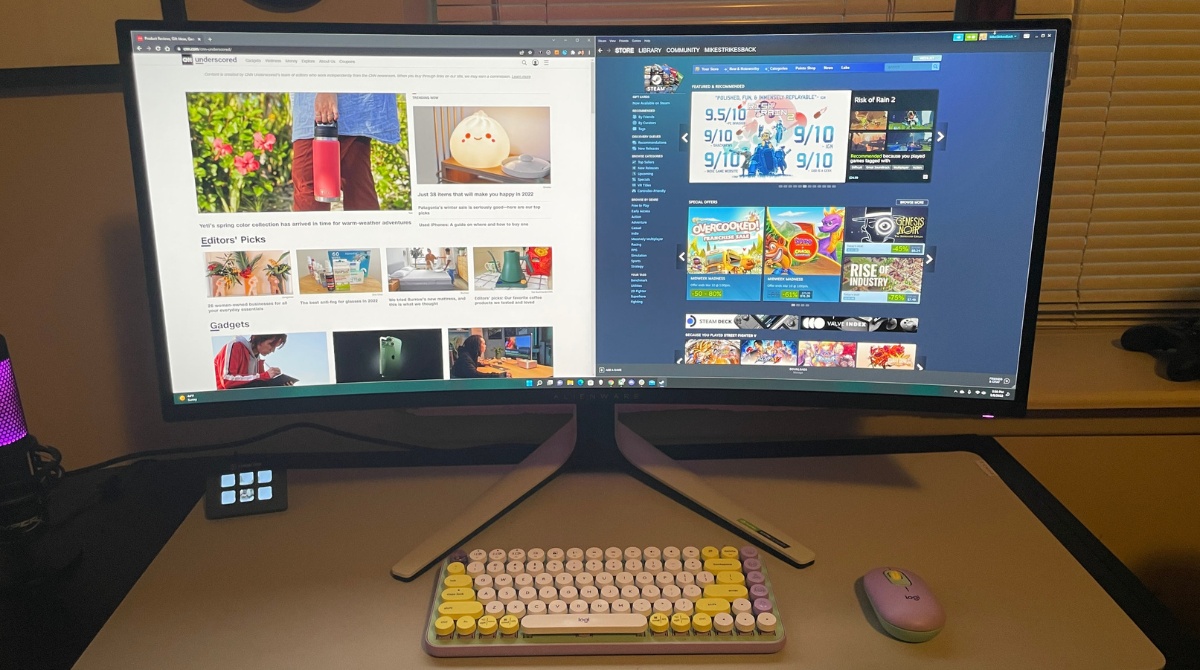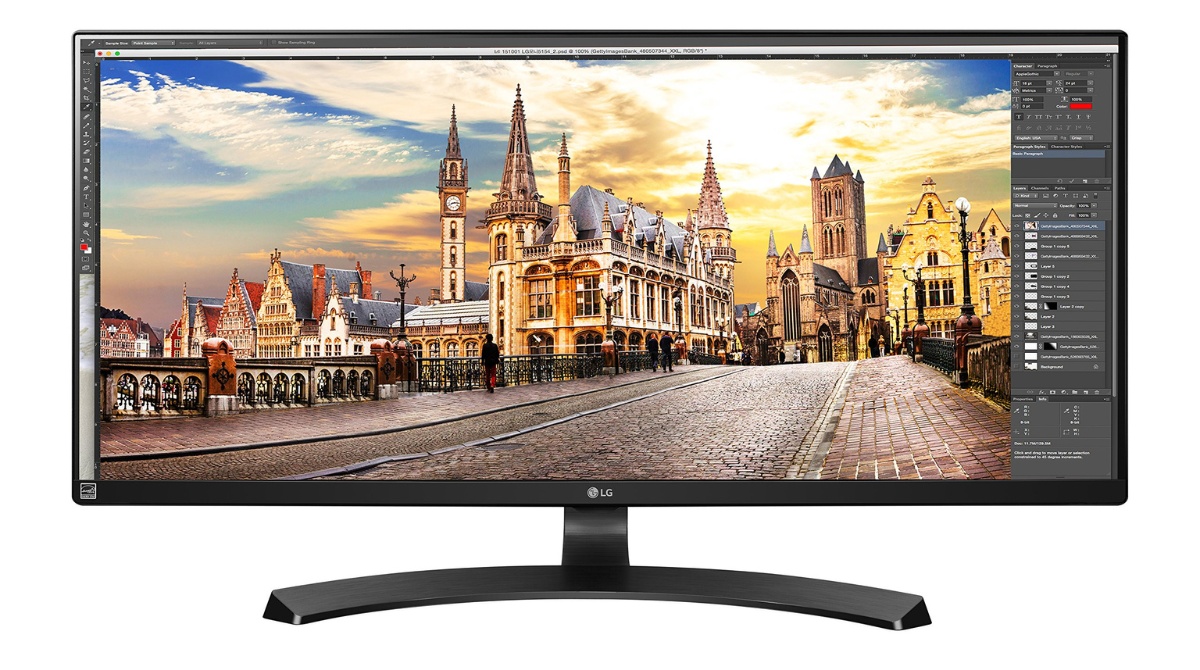Introduction
Welcome to the world of ultrawide monitors! These stunning displays offer a wider aspect ratio compared to traditional monitors, providing you with an immersive and panoramic viewing experience. But did you know that you can take your productivity and multitasking to the next level by splitting an ultrawide monitor?
An ultrawide monitor typically has an aspect ratio of 21:9 or wider, making it ideal for professionals who need to handle multiple applications simultaneously or gamers who crave a more expansive field of view. By splitting the screen, you can create virtual dual or triple monitors – each displaying different content – without the need for multiple physical screens.
Whether you’re a video editor who wants to have a timeline on one side and the video preview on the other, a coder who needs multiple code files simultaneously visible, or a stock trader who wants to monitor multiple financial charts, splitting an ultrawide monitor can significantly enhance your workflow and boost your productivity.
In this article, we’ll explore the different options available for splitting an ultrawide monitor. We’ll discuss both the software and hardware solutions that can help you divide your screen real estate efficiently. Whether you’re using Windows, macOS, or Linux, we’ve got you covered.
Whether you’re a professional or an enthusiast, splitting an ultrawide monitor is a game-changer. It allows you to maximize your work efficiency, improve your multitasking capabilities, and make the most out of the impressive screen real estate that an ultrawide monitor offers.
So, let’s dive in and discover the various ways you can split your ultrawide monitor. Whether you choose software options or hardware solutions, you’re sure to find the method that best suits your needs and enhances your productivity.
What is an Ultrawide Monitor?
An ultrawide monitor is a type of computer monitor that features an aspect ratio wider than the standard 16:9 ratio of traditional monitors. Typically, ultrawide monitors have an aspect ratio of 21:9 or even wider, providing a much broader and more immersive viewing experience.
These monitors are designed to offer a wider field of view, allowing you to see more content horizontally without the need for multiple screens. With their expansive display, ultrawide monitors are particularly popular among professionals in fields such as design, video editing, and gaming.
Compared to traditional monitors, ultrawide monitors provide several advantages. Firstly, they eliminate the need for bezels or gaps between multiple monitors, resulting in a seamless and uninterrupted visual experience. This is especially beneficial for tasks that require side-by-side comparisons or multitasking with different applications.
Additionally, ultrawide monitors offer a more immersive gaming experience. With their wider aspect ratio, they provide a wider field of view, allowing gamers to see more of the in-game environment without the distractions caused by bezels found in multi-monitor setups.
Ultrawide monitors come in various sizes, ranging from 29 inches to a whopping 49 inches or even more. The larger sizes provide an even more expansive viewing experience, but they also require more desk space to accommodate them.
When purchasing an ultrawide monitor, it’s important to consider the resolution as well. Higher resolutions, such as Quad HD (2560×1440) or Ultra HD (3840×2160), offer sharper and more detailed visuals. However, keep in mind that higher resolutions may require a more powerful graphics card to drive the monitor effectively.
Overall, ultrawide monitors have revolutionized the way we work, game, and consume media. With their wider aspect ratio, enhanced productivity, and immersive visual experience, they have become a popular choice for professionals and gamers alike.
Now that we understand the basics of ultrawide monitors, let’s explore the benefits of splitting them to further optimize your workflow and productivity.
Why Split an Ultrawide Monitor?
While an ultrawide monitor offers a wider field of view and enhanced productivity, splitting it takes your multitasking capabilities to a whole new level. Here are a few reasons why you might consider splitting your ultrawide monitor:
- Efficient Multitasking: By splitting your ultrawide monitor, you can have multiple applications or windows visible simultaneously. This allows you to seamlessly switch between tasks without the need to constantly resize or rearrange windows. For professionals who work with multiple software applications or those who need to reference multiple documents at once, splitting an ultrawide monitor makes multitasking much more efficient.
- Enhanced Productivity: Splitting an ultrawide monitor allows you to have more screen real estate dedicated to different tasks. You can have a dedicated workspace for each application, making it easier to organize and focus on your work. Whether you’re a programmer who wants to view code on one side and documentation on the other or a content creator who needs to edit videos and monitor social media feeds simultaneously, splitting an ultrawide monitor can significantly improve your productivity.
- Optimized Workflow: Splitting an ultrawide monitor can streamline your workflow by eliminating the need for multiple physical screens. It reduces the clutter on your desk and simplifies the setup process. With a split screen, you can seamlessly drag and drop files or content between different windows or applications, making the transfer of information smoother and more efficient.
- Gaming Advantage: Gamers can also benefit from splitting an ultrawide monitor. By dividing the screen, you can have game-related tools, such as chat panels, game guides, or live streams, displayed on one side while enjoying the immersive gaming experience on the other side. This allows for a more streamlined gaming setup and keeps all the necessary information readily available without interrupting gameplay.
- Personalization: Splitting an ultrawide monitor offers flexibility in customization. You can arrange windows according to your preferences and work habits, whether it’s a vertical split, a horizontal split, or a combination of both. This level of personalization allows you to design your workspace in a way that best suits your needs and working style.
Overall, splitting an ultrawide monitor unlocks its full potential by maximizing your productivity, multitasking capabilities, and personalization options. Whether you’re a professional seeking an efficient workflow or a gamer looking for an immersive gaming setup, splitting your ultrawide monitor can be a game-changer.
Now that we’ve understood the benefits of splitting an ultrawide monitor, let’s explore the different software and hardware options available to help you achieve this setup.
Software Options for Splitting an Ultrawide Monitor
Splitting an ultrawide monitor can be easily accomplished using software solutions specifically designed for managing multiple windows and screen divisions. These software options offer various features to help you create a customized split-screen setup. Here are some popular software options for splitting an ultrawide monitor:
- Window Manager Software: Window manager software, such as DisplayFusion, AquaSnap, or Divvy, allows you to create custom window layouts, snap windows to specific regions of the screen, and easily resize them. These tools usually offer a variety of pre-defined window configurations, allowing you to split your ultrawide monitor into two or more virtual monitors. With these software options, you can easily manage your windows and applications, maximizing your productivity and optimizing your workflow.
- OS Built-in Features: Depending on your operating system, there may be built-in features that help with splitting an ultrawide monitor. For example, Windows 10 has a feature called Snap Assist, which allows you to easily snap windows to different sections of the screen. The macOS operating system also features Split View, which enables you to split your ultrawide monitor between multiple applications. These built-in options provide a convenient and native way to create a split-screen setup without the need for third-party software.
- Virtual Desktops: Many operating systems, including Windows, macOS, and Linux, offer virtual desktop functionality. This feature allows you to create multiple virtual desktops and switch between them effortlessly. By utilizing virtual desktops, you can dedicate different desktops to various tasks or projects. This effectively simulates a split-screen setup on your ultrawide monitor by switching between desktops to access different applications or windows.
- Third-Party Window Management Tools: In addition to dedicated window manager software, there are other third-party tools available that specialize in managing windows and creating split-screen environments, such as Magnet for macOS or FancyZones for Windows. These tools offer advanced features like customizable window grids and hotkey shortcuts, making it easy to arrange and resize windows on your ultrawide monitor with precision.
- Operating System Tweaks: Sometimes, simply adjusting the settings within your operating system can help achieve a split-screen setup on an ultrawide monitor. This may involve tweaking window management preferences or using window snapping features that are already built-in to the operating system. While these options may be more limited in terms of customization, they can still provide a basic split-screen experience.
With a wide range of software options available, you can find the solution that best fits your needs and operating system. Whether you prefer dedicated window management software or utilize the built-in features of your operating system, these software options make splitting an ultrawide monitor a seamless and efficient process.
In the next sections, we’ll explore how to split an ultrawide monitor on specific operating systems, including macOS, Windows, and Linux.
Using Window Management Tools
Window management tools are a powerful solution for splitting an ultrawide monitor. These tools provide advanced features and customization options to help you create a split-screen setup that meets your specific requirements. Here’s a closer look at how you can use window management tools to effectively split your ultrawide monitor:
- Choose the Right Window Manager: There are several window management tools available, each with its own set of features and capabilities. Take some time to research and find a window manager that aligns with your needs and preferences. Some popular window management tools include DisplayFusion, AquaSnap, Divvy, and Spectacle.
- Install and Set Up the Window Manager: Once you’ve selected a window manager, download and install it on your system. Follow the provided instructions to set up the window manager correctly. This may involve adjusting settings, configuring hotkeys, and defining window layouts.
- Learn the Keyboard Shortcuts: Window management tools typically rely heavily on keyboard shortcuts to perform actions such as resizing windows, moving them to specific locations, or switching between layouts. Familiarize yourself with the keyboard shortcuts provided by your chosen window manager. Practice using them to quickly and efficiently manage your windows.
- Create Split-Screen Layouts: Window management tools allow you to create custom split-screen layouts for your ultrawide monitor. This means you can define how your screen real estate is divided, such as dividing it into two equal halves, creating a vertical split, or even arranging windows in a grid pattern. Experiment with different layouts to find the setup that works best for your workflow.
- Save and Assign Layouts: Many window management tools allow you to save your preferred layouts and assign them to specific hotkeys or triggers. This way, you can easily switch between different split-screen configurations with a simple keyboard shortcut. Being able to quickly switch between layouts enhances your productivity and saves you time when working on different projects or tasks.
- Take Advantage of Additional Features: Window management tools often offer additional features that can further improve your window management experience. These may include features like window snapping, automatic window resizing based on predefined rules, or multi-monitor support. Explore the features of your chosen window manager to make the most of what it has to offer.
By using window management tools, you have the flexibility to create and adapt your split-screen setup according to your specific needs. These tools provide a range of features and customization options that enhance your window management experience and boost your productivity.
In the next sections, we’ll walk you through the process of splitting an ultrawide monitor on different operating systems, including macOS, Windows, and Linux.
Splitting an Ultrawide Monitor on macOS
If you’re using a Mac and want to split your ultrawide monitor, macOS offers a built-in feature called Split View that makes the process seamless. Here’s how you can split your ultrawide monitor on macOS:
- Make sure your ultrawide monitor is connected to your Mac and recognized as a secondary display.
- Open the applications that you want to split between the two sides of your monitor.
- Click and hold the green full-screen button on one of the application windows.
- Drag the window to the left or right edge of your screen until you see the Split View divider.
- Release the mouse button and the window will be snapped to one side of the screen.
- On the other side of the screen, you’ll see thumbnails of your other open applications.
- Click on the thumbnail of the desired application to snap it to the other side.
- The applications will now be split between the two sides of your ultrawide monitor.
- To adjust the size of the split, simply hover your cursor over the divider and drag it left or right.
- To exit Split View, move your cursor to the top of the screen to reveal the menu bar and click on the green full-screen button of one of the applications.
With the Split View feature, you can easily split an ultrawide monitor into two equal halves, allowing for efficient multitasking and improved productivity. This built-in functionality eliminates the need for third-party software and simplifies the process of creating a split-screen setup on macOS.
It’s worth noting that Split View on macOS can also be used with multiple ultrawide monitors. You can have separate Split View setups on each monitor or extend the Split View across multiple displays, giving you even more flexibility in your workspace organization.
Now that you know how to split an ultrawide monitor on macOS, let’s move on to the next section where we’ll explore how to achieve a split-screen setup on Windows operating systems.
Splitting an Ultrawide Monitor on Windows
Splitting an ultrawide monitor on Windows can be accomplished using several methods, including built-in features and third-party software. Here are a few ways you can achieve a split-screen setup on Windows:
Using Snap Assist:
- Open the applications that you want to split between the two sides of your monitor.
- Click and hold the title bar of one of the application windows.
- Drag the window to the left or right edge of your screen until you see a translucent outline appear.
- Release the mouse button, and the window will snap to one side of the screen.
- The other side of the screen will display thumbnails of your other open applications.
- Click on the thumbnail of the desired application to snap it to the other side.
- You can adjust the size of each split by dragging the dividing line between the windows.
- To exit the split-screen setup, click and drag the dividing line away from the edge of the screen or use the maximize button on either window.
Using Third-Party Window Management Software:
- Download and install a third-party window management software such as DisplayFusion, AquaSnap, or FancyZones.
- Follow the provided instructions to set up the software and learn its features.
- Most window management software allows you to create custom split-screen layouts by defining window sizes and positions.
- Use the software’s interface or keyboard shortcuts to split your ultrawide monitor according to your desired configuration.
- Experiment with different layouts and settings until you find the split-screen setup that works best for you.
With built-in features like Snap Assist and the availability of window management software, splitting an ultrawide monitor on Windows is a straightforward process. These options provide flexibility and customization, allowing you to create a productive and customized split-screen setup on your Windows operating system.
Now that you know how to split an ultrawide monitor on Windows, let’s move on to the next section where we’ll explore how to achieve a split-screen setup on Linux systems.
Splitting an Ultrawide Monitor on Linux
Splitting an ultrawide monitor on Linux can be achieved using the built-in features of the desktop environment or by utilizing third-party window management tools. Here’s how you can achieve a split-screen setup on Linux:
Using Desktop Environment Features:
- Gnome: Gnome, one of the popular Linux desktop environments, offers a built-in feature called Activities. Click on the Activities button in the dock or press the Super key, then drag an application window to the left or right edge of the screen. The window will automatically resize and snap to that side. Alternatively, you can use the Tilix terminal emulator, which allows you to create multiple split panes within a single terminal window.
- KDE: KDE Plasma, another popular Linux desktop environment, provides a feature called Activities. Open the Activities overview by clicking on the Activities button in the panel or pressing the Super key. From there, you can drag a window to the left or right edge of the screen to snap it into place. You can also use the built-in KWin window manager to create custom window rules and layouts for splitting the screen based on specific criteria.
Using Third-Party Window Management Tools:
- i3: i3 is a popular tiling window manager for Linux that allows you to easily split your ultrawide monitor into different configurable layouts. By using keyboard shortcuts and commands, you can effortlessly arrange windows in a tiling fashion, creating a split-screen setup that suits your workflow.
- Openbox: Openbox is a lightweight window manager that offers flexibility and customization options. With Openbox, you can configure window tiling and create custom keybindings to split your ultrawide monitor based on your preferences. Although it requires some configuration, Openbox provides extensive control over window management.
- Other Window Managers: There are various other window managers available for Linux, such as Xmonad, AwesomeWM, and dwm. These window managers offer advanced tiling and window management capabilities, allowing you to easily achieve a split-screen setup on your ultrawide monitor.
Linux provides a range of options for splitting an ultrawide monitor, from utilizing desktop environment features to taking advantage of powerful third-party window managers. These options give you the flexibility to create a customized split-screen setup that enhances your productivity and multitasking capabilities.
Now that you know how to split an ultrawide monitor on Linux, you have the tools to optimize your workspace and workflow on your Linux system.
Hardware Options for Splitting an Ultrawide Monitor
In addition to software solutions, there are hardware options available that allow you to split an ultrawide monitor. These options can provide more physical control and flexibility over your screen division. Here are some hardware options to consider for splitting an ultrawide monitor:
- Video Wall Controllers: Video wall controllers are devices designed to split a single display into multiple sections, effectively creating a multi-screen setup. They take a single input from your computer and distribute it across the different sections of the monitor. Video wall controllers typically offer various configuration options and display modes, allowing you to divide your ultrawide monitor into different layouts. These devices are commonly used in professional settings such as control rooms, retail displays, and entertainment venues.
- KVM Switches: KVM (Keyboard, Video, Mouse) switches are useful when you have multiple computers and want to share a single ultrawide monitor. They allow you to switch between different computers using a single set of peripherals, including the monitor. Some KVM switches support ultrawide monitors and offer functionality to split the screen between connected devices. This allows you to effectively create a split-screen setup by seamlessly switching between different input sources.
- External Monitor Controllers: External monitor controllers, such as those offered by Matrox or Dell, provide additional functionality for splitting an ultrawide monitor. These devices connect to your computer and expand the possibilities of screen division. They often offer features like Picture-by-Picture (PbP) and Picture-in-Picture (PiP), which allow you to display multiple inputs simultaneously on different sections of the ultrawide monitor. With an external monitor controller, you can create custom split-screen layouts and easily manage multiple sources on a single display.
- Thunderbolt/USB-C Docking Stations: If your ultrawide monitor supports Thunderbolt or USB-C connectivity, you can consider using a docking station that offers multiple video outputs. These docking stations connect to your computer and provide additional video ports, allowing you to connect multiple monitors. By connecting multiple monitors alongside your ultrawide display, you can effectively create a split-screen setup with expanded screen real estate.
When considering hardware options for splitting an ultrawide monitor, it’s important to ensure compatibility with your specific monitor model, connectivity options, and external devices. Additionally, make sure to review the specifications and features of the hardware to determine if it meets your specific requirements.
Hardware solutions provide a more tangible and hands-on approach to splitting an ultrawide monitor. They offer benefits such as easy switching between inputs, support for multiple devices, and advanced configurations for division options. These options give you more control over your split-screen setup and can be especially valuable for professional use or when dealing with multiple computers or sources.
Now that we’ve explored the hardware options for splitting an ultrawide monitor, let’s summarize the key points discussed in this article.
Conclusion
Splitting an ultrawide monitor is a great way to maximize productivity and make the most out of the expansive screen real estate that these monitors offer. Whether you choose to split your monitor using software options or opt for hardware solutions, there are various methods available to help you create a customized split-screen setup that meets your specific needs.
Software options, such as window management tools or utilizing the built-in features of your operating system, offer flexibility and convenience. They allow you to easily divide your ultrawide monitor into multiple sections, manage windows efficiently, and switch between tasks seamlessly. With a wide range of software choices available, you can find the solution that best fits your operating system and desired level of customization.
On the other hand, hardware options provide physical control and flexibility over your screen division. Video wall controllers, KVM switches, external monitor controllers, and docking stations offer unique features to split and manage your ultrawide monitor. These hardware solutions are particularly beneficial in professional settings, multi-computer environments, or when you require advanced configurations for screen division.
By splitting an ultrawide monitor, you can enhance multitasking, optimize workflow, and personalize your workspace. Whether you’re a professional working with multiple applications, a gamer seeking an immersive gaming setup, or someone who simply wants to improve productivity, splitting your ultrawide monitor can make a significant difference.
Now that you have a comprehensive understanding of the options available for splitting an ultrawide monitor, it’s time to explore the methods and tools that best suit your needs. Experiment with different software solutions, consider hardware options if necessary, and customize your split-screen setup to enhance your productivity and maximize your work or gaming experience.
Remember, whether you’re a designer, developer, trader, or enthusiast, splitting an ultrawide monitor can empower you to take your workflow to the next level. Embrace this technology, optimize your screen real estate, and enjoy the benefits of a truly immersive and productive computing experience.







